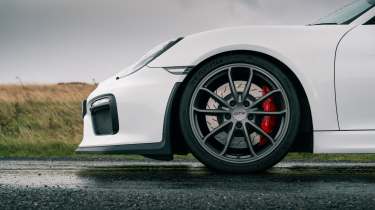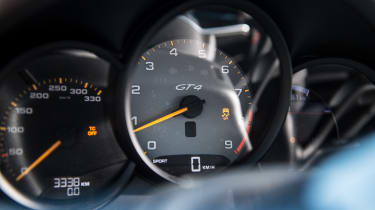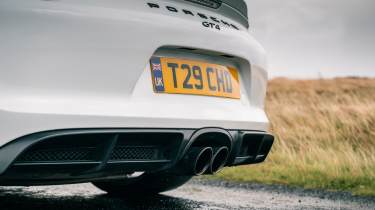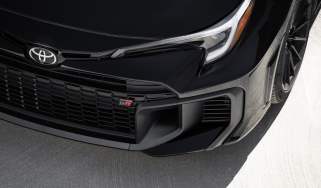Used Porsche Cayman GT4 (981, 2015 – 2016) review: a flat-six hero from £55k
The appeal of one of our favourite sports cars hasn’t diminished a decade on from launch
Porsche took a while to get around to a true GT department variant of the Cayman. The first-generation car was never so lucky; launched in 2005, even the standard Cayman S could give a Porsche 911 a run for its money, and perhaps that’s what the company was afraid of, the brilliant mid-engined coupe treading too heavily on the toes of its performance flagship. Eventually Porsche did see fit to release the Cayman R, alongside the original Boxster Spyder in 2011, but while it shed around 55kg from the S and looked a little more aggressive, this was still clearly a platform being held back from its full potential.
The 981-generation Boxster and Cayman debuted in 2012, with an all-new platform, revised styling and new engines, but still no top-flight car – until 2015, when Porsche finally relented and gave us the Cayman GT4.
> Porsche 718 Cayman GT4 review
This was the first time Porsche’s GT department had laid its hands on the Cayman, and the results were just as stunning as we had always hoped they might be. It emerged victorious from eCoty 2015 on Scotland’s challenging North Coast 500, even though it was in a group that also included the wild Lamborghini Aventador SV, blistering McLaren 675LT and Porsche’s own 911 GT3 RS in 991.1 form.
More reviews
In-depth reviews
Reviews
- Porsche 718 Cayman GT4 (2020 - 2025) review: an instant modern classic
- Porsche 718 GT4 ePerformance 2022 review – the electric racer you'll want to watch
- Porsche 718 Cayman GT4 Clubsport 2022 review
- Porsche 718 Cayman GTS 4.0 2020 review - a cut-priced GT4?
- RPM Technik Porsche Cayman (981) CSR review
- SharkWerks Porsche Cayman GT4 review
That GT4 carried on until the Cayman was updated in 2016, with the internal code 982 reflecting relatively minor changes, but the addition of the 718 prefix to the external designation reviving a name from Porsche’s past. While the basic 718 Cayman and Cayman S now had four-cylinder power, Porsche thankfully wasn’t done with flat-six engines nor the GT4 badge just yet, and the 718 GT4 debuted in 2019, with a GT4 RS following in 2021.
For
- One of the best sports cars of the past decade
- Handling is just about as good as it gets
- Every control feels like it’s been honed to perfection
Against
- Overly long gearing reduces opportunities to extend the engine on the road
- Hefty tax bills for pre-April 2017 cars
- Similar money also gets you a 996 GT3…
evo verdict
The Cayman GT4 remains one of the great driver’s cars, offering the complete package of performance, handling and usability. Yes, its gear ratios may be a little long (slightly improved in its 718-generation successor), but the razor-sharp responses of the naturally aspirated 3.8-litre flat-six, the weighting of the controls and the just-so chassis balance quickly push this concern to the background. Where other performance cars can seem obsessed with achieving mind-boggling numbers at the expense of driver enjoyment, the GT4 doesn’t fall into this trap.
Engine, gearbox and technical highlights
- 3.8-litre engine may not have Motorsport cred, but it’s still a cracker
- GT3 suspension components aid handling
- Well-judged aero kit gives the GT4 just enough visual clout
The first Cayman GT4’s technical constitution was a deftly handled one. On the one hand, it didn’t step on the toes (too much) of the 991-generation 911 GT3, which kept its howling 9000rpm Porsche Motorsport flat-six to itself. But at the same time, the GT4 was no stickered-up rebadge with a wing.
The Cayman GT4 borrowed the 991 911 Carrera S’s 3.8-litre Powerkit engine, which gives the car plenty of straight-line performance. Low-down torque is strong, and with the red line set at 7800rpm it has good top-end reach, too. Being a highly tuned, normally aspirated engine, throttle response is razor sharp, which means you can precisely manipulate the rear axle under power.
The six-speed manual gearbox is one of the best around. The shift action is so sweet you change gears just for the tactile joy of it. It’s just a shame that the standard 981’s overlong gear ratios remained, meaning you rarely need to leave third gear most of the time. The extra torque of the 3.8 does disguise the problem to some degree, but with shorter ratios the engine would feel punchier still, and you could enjoy the gearshift more often.
Indeed the aftermarket has answered calls for shorter ratios in this transmission, though it requires quite the financial commitment. Our preference, too, would be for a dedicated button to make the automatic throttle blip independently switchable, to allow it to be turned off in Sport mode.
A big technical change for the Cayman GT4 over the standard 981 family was in the front suspension, where it inherited the split wishbones and larger wheel bearings of a type seen initially on the 991 GT3. This allowed individual manual adjustment of the car’s geometry to tune the front axle for road or circuit use.
Model |
Power |
Torque |
0-62mph |
Top speed |
| Porsche Cayman GT4 | 380bhp | 310lb ft | 4.4sec | 183mph |
Driver’s note
‘When it was new I remember people complaining about the standard Carrera engine, but it’s got loads of character and sounds really special, especially in today's context. In fact as a whole I think I'd have more fun in a GT4 than a new GT3 on the road’ – Yousuf Ashraf, senior staff writer, drove the Porsche Cayman GT4 on evo’s six-cylinder sports car test in issue 339
Performance, ride and handling
- Plenty of performance and a soulful engine note
- Handling is as good as it gets, communicative and adjustable
- Firm suspension, but totally unflappable over all surfaces
One of the signature dynamic traits of any Cayman is the impression it gives in cornering of leaning on both the front and rear axles equally hard. That means there’s no sense of the car understeering heavily or of the rear end trying to break free. With both axles digging into the road surface, you feel as though you’re sitting right at the pivot point of the chassis. This means you’re wonderfully in tune with the car, knowing instinctively how hard you can work the tyres.
The fitment of the 911 GT3’s heavily uprated front axle on the Cayman GT4 is a boon. Whereas a Cayman GTS can feel a touch vague, particularly in transient conditions, with remote steering and an unclear picture of where the limit of front axle grip is, the GT4 is completely intuitive. Its steering is so much sharper and more communicative, the wheel writhing in your hands rather than being lifeless.
There is a trace of understeer on initial turn-in – it’s built into the chassis rather than being a shortfall of grip – but there’s so much agility and adjustability that you can trim it out by trail-braking, or otherwise ride it out for a fraction of a second until you reach the apex, then neutralise the car on the throttle. That level of engagement is what driving enthusiasts live for.
Of course, the GT4 is a stiffer-sprung car than the standard 981s on which it was based, which gives it even tauter body control and roll resistance, but in proper Porsche Motorsport tradition it also rides a bumpy road surface with abundant damping quality. The body is never skipped around or upset by lumps and bumps, and never does the chassis run out of suspension travel in compressions.
The limited-slip differential works with the sticky Michelin Pilot Sport Cup 2 tyres that GT4s first shipped with to find massive traction at corner exit. When you consciously overload the driven wheels, the diff then gives a very clean and predictable breakaway, which helps to make the car even more playful.
The 981 Cayman GT4 was certainly one of the most technically capable performance car chassis at any price point when new, but the Cayman GT4 was also enormous fun to drive down a winding stretch of road. Still is, on both counts.
Driver’s note
‘It's so pure and precise, and it lets you drive it in any way you want. It'll do neat and fast, but it's so predictable and progressive when you bully it around more. Being a GT product I thought it'd be quite full-on, but it's actually really civilised when you aren't going for it.’ – Yousuf Ashraf, senior staff writer, drove the Porsche Cayman GT4 on evo’s six-cylinder sports car test in issue 339
MPG and running costs
- Fuel economy isn’t too bad for the performance
- Larger fuel tank option means more than 300 miles between fills
- GT4s are generally reliable, though need careful maintenance
Time was when a car of the Cayman GT4’s performance would have landed you a fuel economy figure in the teens. Spend your life on track or in town and that’s probably still the case, but an official combined economy figure of 27.4mpg isn’t shabby at all, while owners report numbers in the low to mid 20s depending on their driving style. It’s not unusual to see more than 30mpg on the motorway either – one place the Cayman’s yawning gear ratios really come into their own. The GT4 came with two fuel-tank options, 55 litres and 64 litres. The smaller will get you 250+ miles from a fill at 25mpg, the latter stretches that to more than 300 miles.
Tax may set you back a few bob if you buy a pre-April 2017 car, since 238g/km of CO2 is in the second-highest band, for a £735 annual bill. From April 2017 onwards though, this drops to only £195 a year.
Not only is the GT4 an outstanding driver’s machine, it’s reliable too – if the car has been well maintained and cared for. Given it has a manual gearbox and is a prime candidate for track use, checking for over-rev reports is wise, as is looking for the usual brake, bearing and bush wear associated with hard circuit driving.
Some cars were recalled due to a gearbox fault, so ensure this has been actioned if it was affected. Dampers, catalysts and dynamic engine mounts have been known to fail, and in rare instances strut towers have had catastrophic failures – this wouldn’t be easy to hide, but check for below-par repair work to be on the safe side.
Interior and technology
- Cabin design and quality are both excellent
- 918-style bucket seats and a half cage were optional, but not essential
- Perfect driving position and tactile control surfaces
The basic architecture of the GT4 was unsurprisingly shared with that of other 981 Caymans, but that’s no bad thing. Quality was, and still is, as good as you’ll find on a car in this class; the driving position is basically perfect, with no offset to the controls and plenty of adjustment; and the 981 Cayman neatly sneaks into that era of performance cars where a decent infotainment system was standard, but you’re not dependent on the touchscreen or constantly being nagged by half-baked driver assistance systems.
A half cage was optional, as were the carbon bucket seats also seen in the 991 GT3s at the time, as well as the 918 Spyder hypercar. That said, the standard Sport seats, while seemingly uncommon in GT4s, are still excellent, being comfortable and supportive; don’t write them off if you mostly drive on the road.
The three-spoke, suede-trimmed wheel is just about perfect too, in terms of size, rim thickness, and its simple and elegant design. Touches like the Sport Chrono clock between the dash vents, and the pull-strap door releases, add just enough theatre to elevate the GT4 over regular 981s.
Prices and buying options
When it launched in 2016, the Cayman GT4 started at £64,451, and Porsche sold every example it intended to make. As a result, anyone who missed out and wanted to get hold of a GT4 had to spend significantly more than that. GT4 silly season saw nearly new examples rising to over £100,000 at its peak.
Today, the market clearly still understands just how great the original Cayman GT4 is, although thankfully prices have settled since the madness of its launch. All these years later, used prices are hovering back between £55,000 and £65,000. In the context of new-car prices in 2025, where a Cupra Ateca is a £50,000-plus car after some options, the GT4 seems reasonably priced for what is one of the finest driver’s cars of the last decade.
Rivals? The Lotus Evora 400 and the Sport 410 were hugely talented – on flowing along British B-roads perhaps better even than the GT4 – and start at under £50k. Not as polished as the Porsche, they’re still great driver’s cars. Another temptation towards the top of the GT4 price range would be a Porsche 996 GT3. We recently drove an example with under 60,000 miles, and in great condition, that was up for sale for £67,000. Even more interactive and characterful than the GT4, it would be very tempting indeed.
Model |
evo rating |
Price |
Kerb weight |
Power |
0-62mph |
| Porsche 981 Cayman GT4 | 5.0 | £55-65k | 1340kg | 380bhp | 4.4sec |
| Lotus Evora Sport 410 | 4.5 | £45-55k | 1325kg | 410bhp | 4.2sec |
| TVR T350C | 4.5 | £30-45k | 1187kg | 350bhp | 4.7sec |
| BMW Z4 M Coupe | 4.5 | £15-25k | 1420kg | 338bhp | 5.0sec |
Porsche Cayman GT4 specs
| Engine | Flat-six, 3800cc |
|---|---|
| Power | 380bhp @ 7400rpm |
| Torque | 310lb ft @ 4750-6000rpm |
| Weight | 1340kg |
| Power-to-weight | 288bhp/ton |
| 0-62mph | 4.4sec |
| Top speed | 183mph |
| Price new | £64,451 (2015) |










